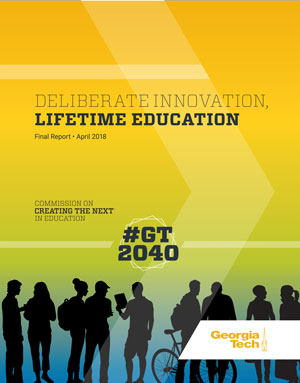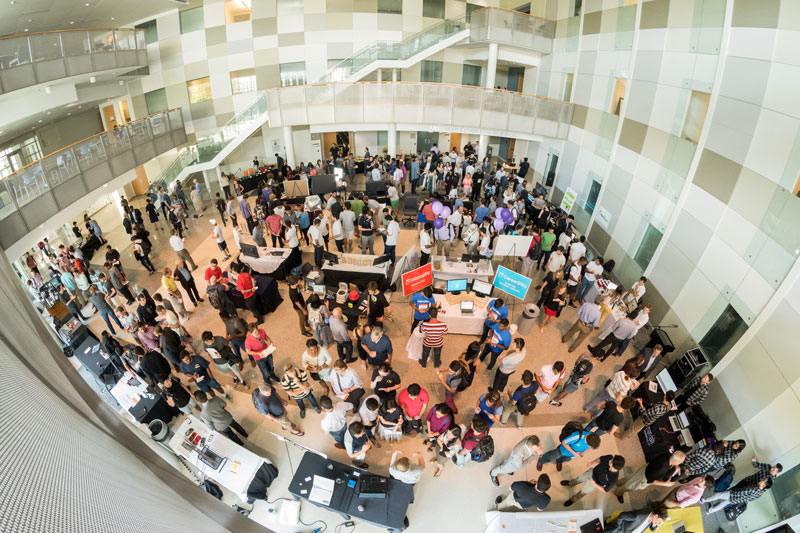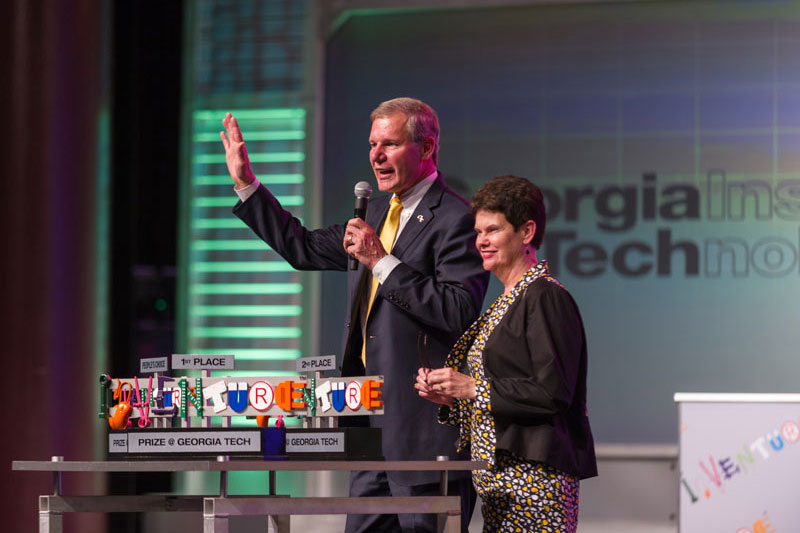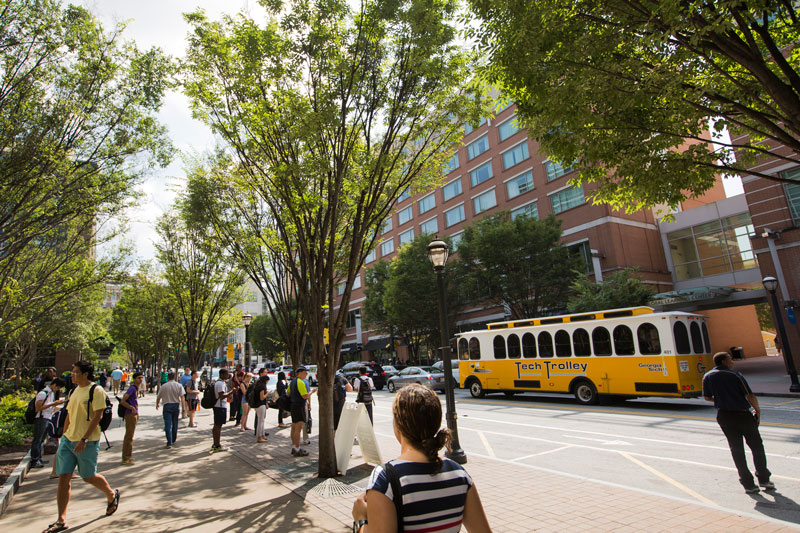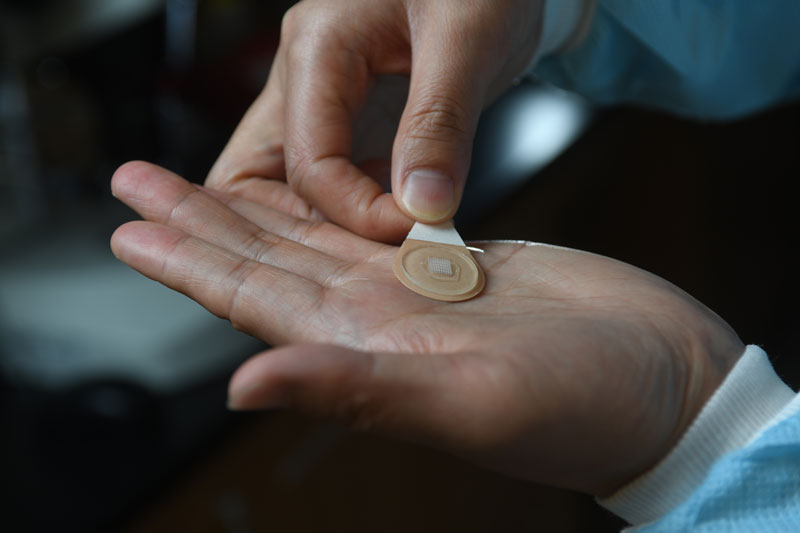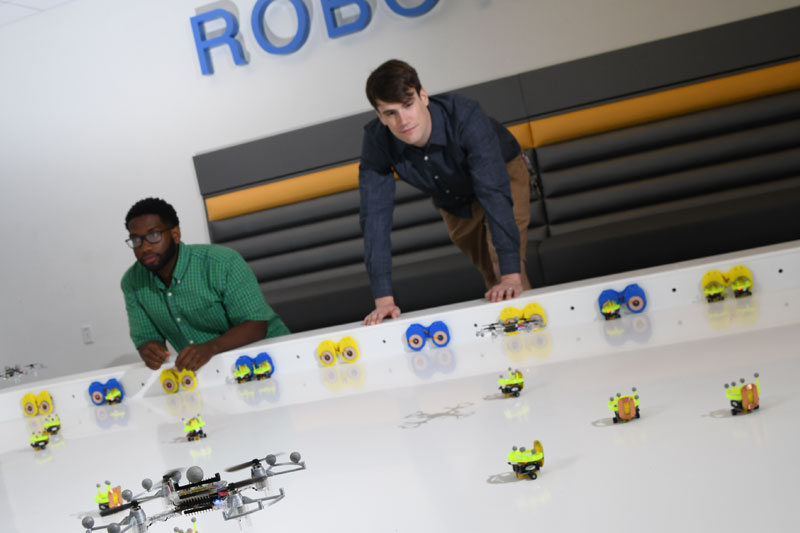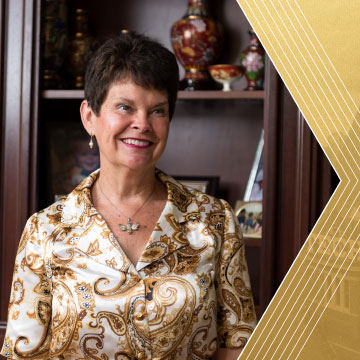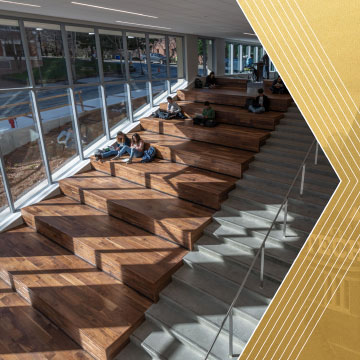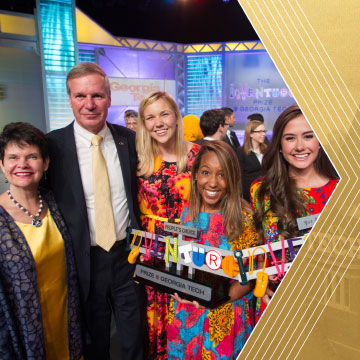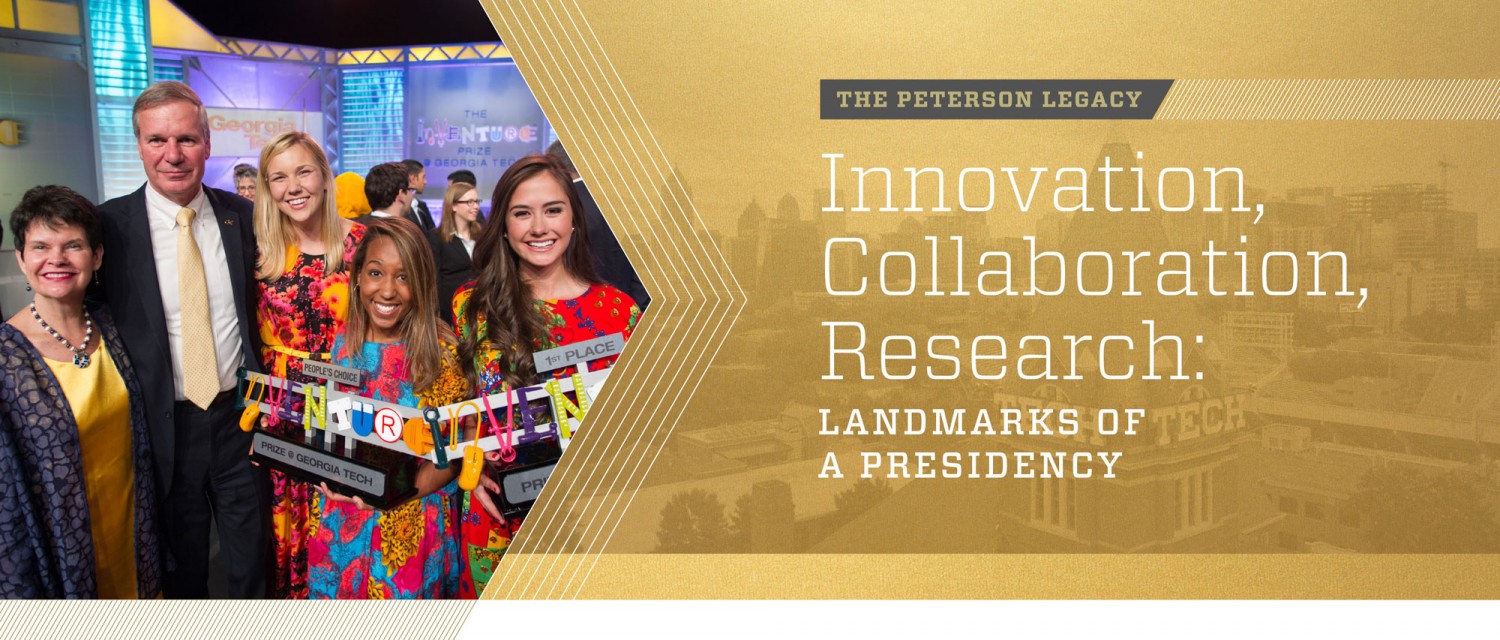
From advances in teaching techniques and student entrepreneurship to groundbreaking discoveries in the lab, the G.P. “Bud” Peterson years (2009-19) will be remembered as ones in which innovation, collaboration, and research drove the Institute and further solidified its reputation as a world-class university.
Virtual Learning
Under President Peterson, Georgia Tech began to tap into the vast potential of Massive Open Online Courses (MOOCs) and expanded other online learning opportunities. Between 2012 and 2018, Georgia Tech’s MOOCs had a total of more than 3.7 million enrollments. In 2018, Georgia Tech Professional Education served more than 36,000 learners worldwide, representing 2,624 organizations, by delivering courses, program certificates, and master’s degrees. Contract courses were delivered to 223 companies and industry partners.
Lessons learned during the growth of MOOCs laid the foundation for Georgia Tech to develop three Online Master of Science programs that have become highly popular. The Online Master of Science in Computer Science began five years ago as a partnership among Tech, AT&T, and Udacity. It started with 380 students and now serves 8,600, representing all 50 states and 120 countries.
The program’s success inspired the launch of two additional degree programs, the OMS in Analytics and the OMS in Cybersecurity. In less than two years, Tech’s OMS in Analytics now has about 3,000 students and 34 graduates. Launched in January 2019 with 250 students, the OMS in Cybersecurity program is expected to add 450 students in Fall 2019.
Further, Georgia Tech pioneered the use of virtual teaching assistants when it used IBM’s Watson platform to introduce “Jill Watson” in Spring 2016 during Knowledge Based Artificial Intelligence (KBAI), a core course of the College of Computing’s Master of Science in Computer Science degree program. The number of virtual assistants has since expanded, and virtual teaching assistants, as illustrated by Jill Watson, have been recognized by the Chronicle of Higher Education as one of the most transformative technologies to impact college within the past 50 years.
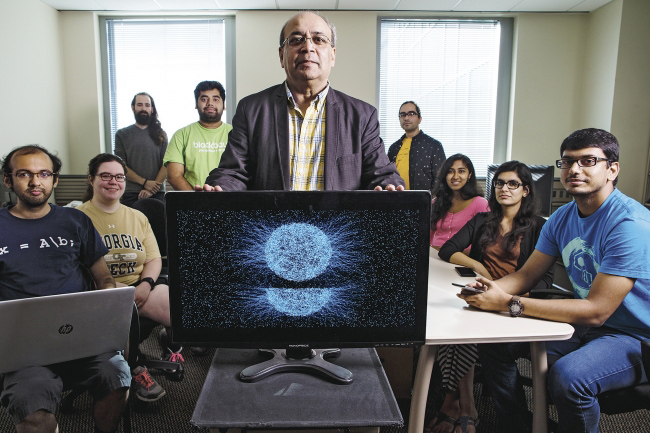
Jill Watson researcher Ashok Goel. Photo credit: Dustin Chambers
Creating the Next in Education and Entrepreneurship
In Spring 2018, Georgia Tech introduced the report, “Deliberate Innovation, Lifetime Education.” It was the result of two years of work by more than 50 faculty, students, and staff participating in the Commission on Creating the Next in Education (CNE). CNE’s work resulted in a proposal called the Georgia Tech Commitment to a Lifetime Education.
In the realm of entrepreneurship, with a major gift from alumnus Chris Klaus, the Institute and the College of Engineering, in April 2015, formally launched CREATE-X, a collective of programs to boost students’ entrepreneurial confidence and provide the tools necessary for establishing startups. Open to undergraduates across campus, CREATE-X is based on three principles: learn, make, launch. Students advance through all three concepts and graduate equipped with entrepreneurial skills to succeed in both startup settings and in larger, well-established companies.
In Peterson’s first year, Georgia Tech also launched the InVenture Prize, an innovation competition for Tech’s undergraduate students and recent bachelor's graduates. Finals are televised live by Georgia Public Broadcasting. Contestants take their inventions before a panel of expert judges, with the winner receiving $20,000 and a free U.S. patent filing. Several contestants have used InVenture as a springboard to take their products to market. InVenture has spawned three other annual competitions: the Georgia K-12 InVenture Prize, the Atlantic Coast Conference (ACC) InVenture Prize, and the Georgia InVenture Prize, open to students attending public and private colleges throughout the state.
Tech Square
Technology Square was already established on Georgia Tech’s campus when President Peterson arrived in 2009. But he then helped drive the midtown Atlanta development to become one of the nation’s top innovation neighborhoods. Tech Square has the highest density of startups, corporate innovators, and academic researchers in the southeastern U.S. Since 2012, 35 corporate innovation and research centers and partners have located in and around Tech Square. Innovation neighborhoods have grown significantly in areas on and near the campus during President Peterson’s tenure, including the Global Center for Medical Innovation, the Carbon Neutral Energy Solutions Laboratory, and the Boeing Manufacturing Development Center.
Then, in October 2016, the Georgia Tech Foundation finalized purchase of the historic Biltmore. The building has approximately 290,000 square feet of loft office, retail, and ballroom space, and houses a number of startups. Georgia Tech uses the facility for both small and large events, including the Ivan Allen Jr. Prize for Social Courage ceremony.
President Peterson also coordinated with the Board of Regents, John Portman and Associates, and investors to bring Coda to Tech Square. Coda, which opened in Spring 2019, is a high-rise building that will include Georgia Tech’s high performance computing center, startups, and corporations. Peterson has initiated work on Tech Square Phase III, to include a new high-rise building for Georgia Tech’s H. Milton Stewart School of Industrial and Systems Engineering and the Scheller College of Business.
Bioengineering Advances
Supported by the largest building investment in Tech history, the Roger A. and Helen B. Krone Engineered Biosystems Building opened in May 2015 on the Tech campus. Peterson led the effort to secure 100% funding, made possible through state of Georgia contributions, a Georgia Tech investment, and private donors. It is leading the way in convergent science at the intersection of the life sciences, physical sciences, and engineering. Children’s Healthcare of Atlanta researchers share the facilities and collaborate with Georgia Tech researchers on numerous projects.
Collaborative efforts between Georgia Tech, Children’s, Emory University, and the Global Center for Medical Innovation came together in Summer 2018 to result in the design and creation of 3D-printed, customized splints. In a groundbreaking surgery, Children’s clinicians placed the splint around the trachea and bronchi to hold the airways open in a 7-month-old boy who couldn’t breathe without the help of a machine.
In September 2017, the National Science Foundation (NSF) announced that it would award $20 million to a consortium of universities led by Georgia Tech to establish a new engineering research center (ERC) in cellular manufacturing. Building on an earlier gift of $16 million from The Marcus Foundation, it became Georgia Tech’s first NSF ERC grant in 20 years. The NSF Engineering Research Center for Cell Manufacturing Technologies could help revolutionize the treatment of cancer, heart disease, autoimmune diseases, and other disorders by enabling broad use of potentially curative therapies that utilize living cells — such as immune cells and stem cells — as “drugs.”
Working with the Atlanta-based Centers for Disease Control and Prevention (CDC), Georgia Tech researchers are developing a microneedle patch that could make it easier to vaccinate people against vaccine-preventable diseases such as measles. The patch is designed to be administered by minimally trained workers and to simplify storage, distribution, and disposal compared with conventional vaccines.
Advanced Manufacturing and Robotics
Significant strides were also made under President Peterson in the field of advanced manufacturing. The Advanced Manufacturing Pilot Facility opened in June 2017 on campus at the intersection of 14th Street and Hemphill Avenue, with Boeing and Delta serving as the anchor sponsors.
In the growing field of robotics, Tech’s Institute for Robotics and Intelligent Machines during the past decade has become an umbrella under which robotics researchers, educators, and students from across campus come together to advance high-powered and diverse activities. In August 2017, Tech opened the Robotarium, a $2.5 million lab funded by the NSF and Office of Naval Research. The 725-square-foot facility houses nearly 100 rolling and flying swarm robots that are accessible to anyone. The Georgia Tech Research Institute (GTRI) Robotic and Autonomous Systems Division is driving innovation in unmanned systems — from basic research to advanced prototypes and test and evaluation.

